Effective Project Quality, Risk, and Procurement Management
VerifiedAdded on 2023/06/12
|10
|3133
|296
Report
AI Summary
This report discusses the importance of quality control, risk assessment, and effective procurement in project management, with a focus on the garment industry. It outlines quality management principles, including commitment, tracking mistakes, training, quality circles, and positive attitudes. The report identifies common garment defects such as broken stitches, untrimmed threads, dimension tolerance, puckering, and incorrect stitches per inch, providing solutions for each. It emphasizes the role of inspection teams and adherence to specifications to ensure quality and prevent losses. The quality control model, involving problem identification, analysis, and correction, is also discussed to ensure continuous improvement and customer satisfaction.
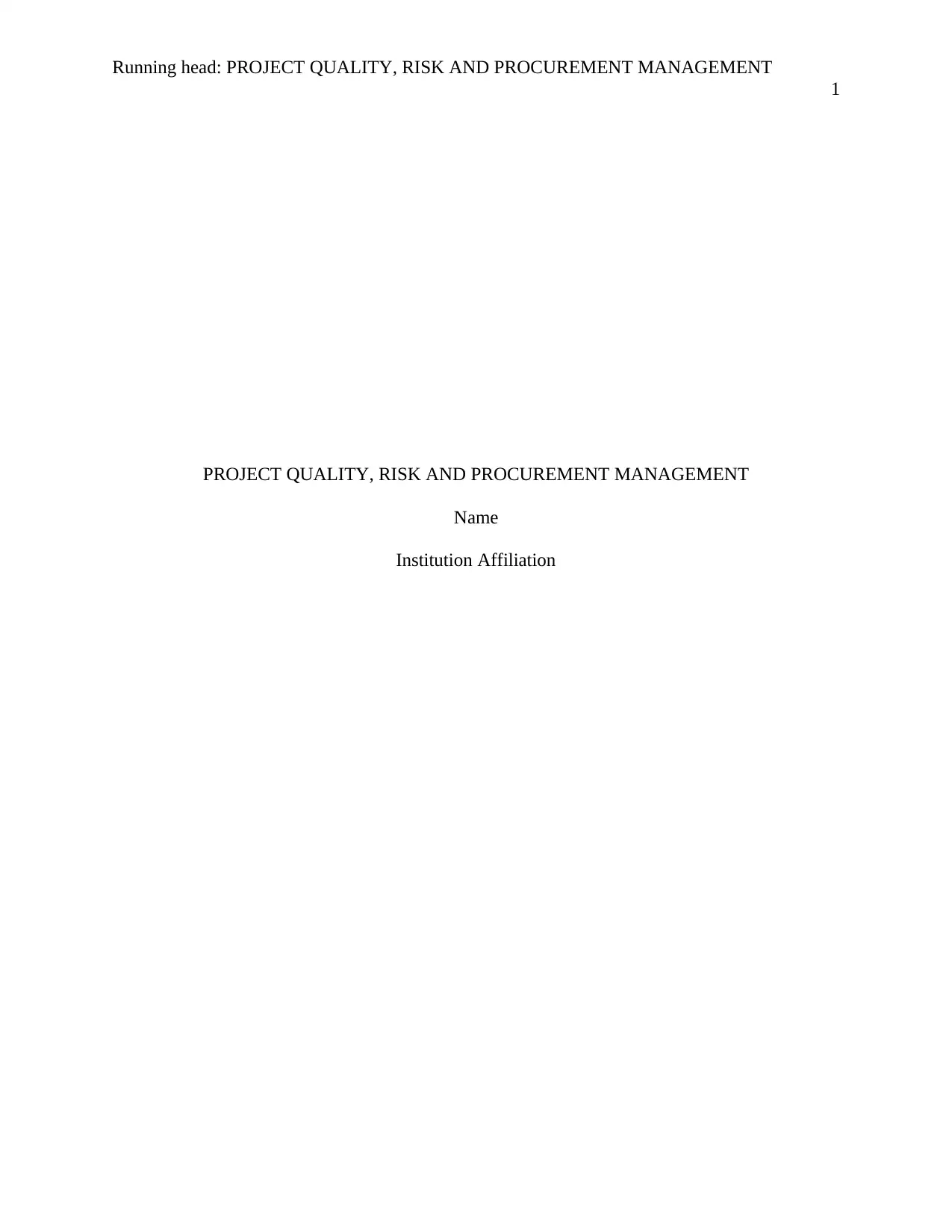
Running head: PROJECT QUALITY, RISK AND PROCUREMENT MANAGEMENT
1
PROJECT QUALITY, RISK AND PROCUREMENT MANAGEMENT
Name
Institution Affiliation
1
PROJECT QUALITY, RISK AND PROCUREMENT MANAGEMENT
Name
Institution Affiliation
Paraphrase This Document
Need a fresh take? Get an instant paraphrase of this document with our AI Paraphraser
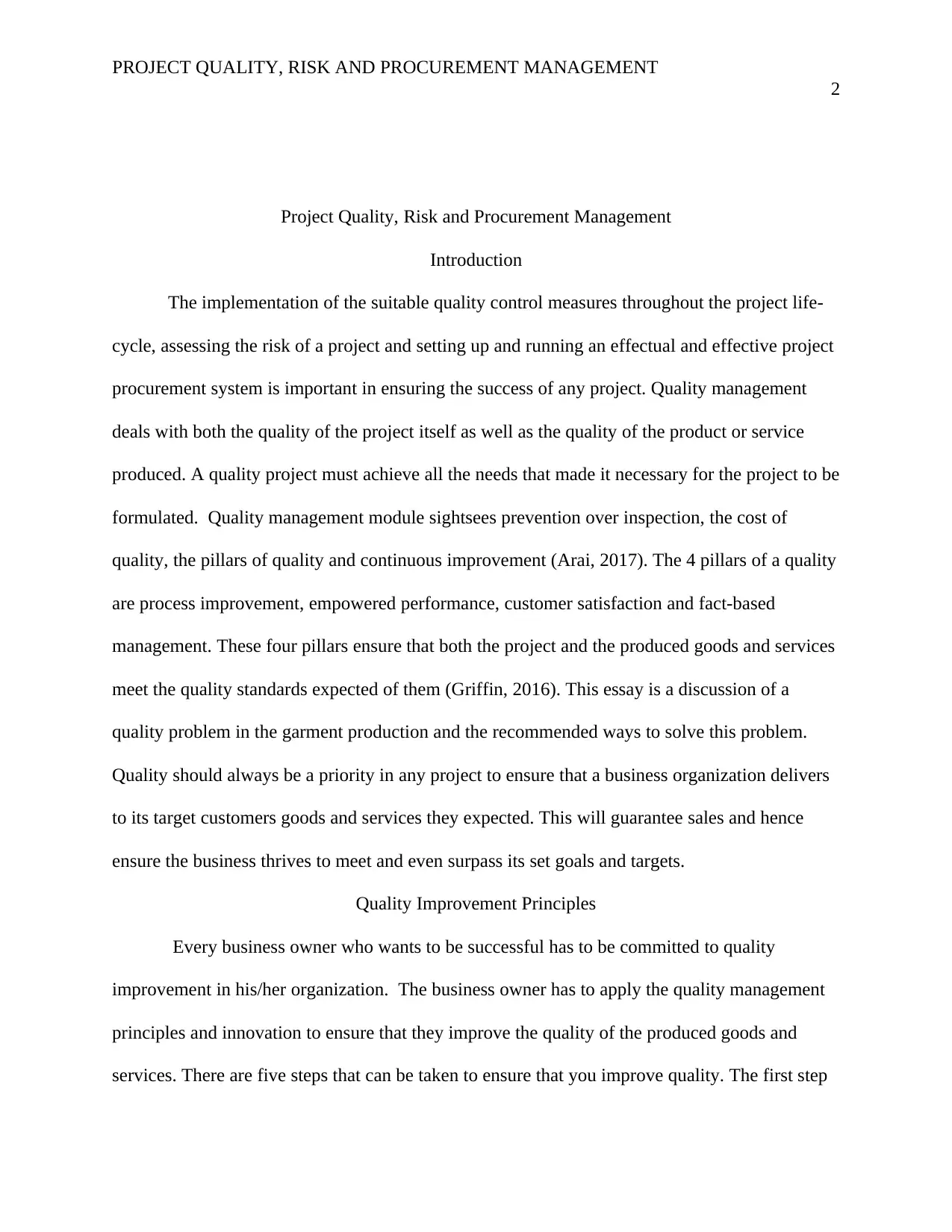
PROJECT QUALITY, RISK AND PROCUREMENT MANAGEMENT
2
Project Quality, Risk and Procurement Management
Introduction
The implementation of the suitable quality control measures throughout the project life-
cycle, assessing the risk of a project and setting up and running an effectual and effective project
procurement system is important in ensuring the success of any project. Quality management
deals with both the quality of the project itself as well as the quality of the product or service
produced. A quality project must achieve all the needs that made it necessary for the project to be
formulated. Quality management module sightsees prevention over inspection, the cost of
quality, the pillars of quality and continuous improvement (Arai, 2017). The 4 pillars of a quality
are process improvement, empowered performance, customer satisfaction and fact-based
management. These four pillars ensure that both the project and the produced goods and services
meet the quality standards expected of them (Griffin, 2016). This essay is a discussion of a
quality problem in the garment production and the recommended ways to solve this problem.
Quality should always be a priority in any project to ensure that a business organization delivers
to its target customers goods and services they expected. This will guarantee sales and hence
ensure the business thrives to meet and even surpass its set goals and targets.
Quality Improvement Principles
Every business owner who wants to be successful has to be committed to quality
improvement in his/her organization. The business owner has to apply the quality management
principles and innovation to ensure that they improve the quality of the produced goods and
services. There are five steps that can be taken to ensure that you improve quality. The first step
2
Project Quality, Risk and Procurement Management
Introduction
The implementation of the suitable quality control measures throughout the project life-
cycle, assessing the risk of a project and setting up and running an effectual and effective project
procurement system is important in ensuring the success of any project. Quality management
deals with both the quality of the project itself as well as the quality of the product or service
produced. A quality project must achieve all the needs that made it necessary for the project to be
formulated. Quality management module sightsees prevention over inspection, the cost of
quality, the pillars of quality and continuous improvement (Arai, 2017). The 4 pillars of a quality
are process improvement, empowered performance, customer satisfaction and fact-based
management. These four pillars ensure that both the project and the produced goods and services
meet the quality standards expected of them (Griffin, 2016). This essay is a discussion of a
quality problem in the garment production and the recommended ways to solve this problem.
Quality should always be a priority in any project to ensure that a business organization delivers
to its target customers goods and services they expected. This will guarantee sales and hence
ensure the business thrives to meet and even surpass its set goals and targets.
Quality Improvement Principles
Every business owner who wants to be successful has to be committed to quality
improvement in his/her organization. The business owner has to apply the quality management
principles and innovation to ensure that they improve the quality of the produced goods and
services. There are five steps that can be taken to ensure that you improve quality. The first step
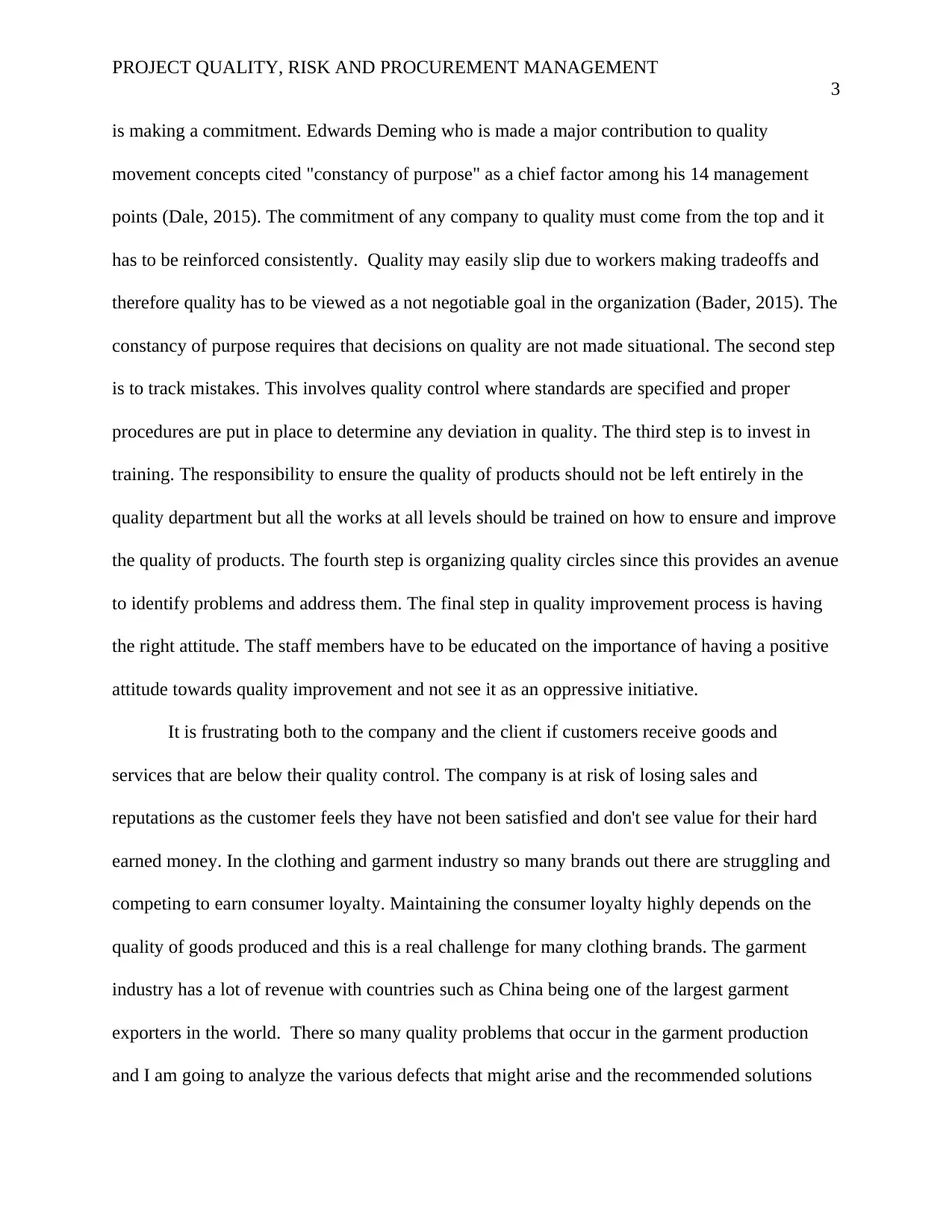
PROJECT QUALITY, RISK AND PROCUREMENT MANAGEMENT
3
is making a commitment. Edwards Deming who is made a major contribution to quality
movement concepts cited "constancy of purpose" as a chief factor among his 14 management
points (Dale, 2015). The commitment of any company to quality must come from the top and it
has to be reinforced consistently. Quality may easily slip due to workers making tradeoffs and
therefore quality has to be viewed as a not negotiable goal in the organization (Bader, 2015). The
constancy of purpose requires that decisions on quality are not made situational. The second step
is to track mistakes. This involves quality control where standards are specified and proper
procedures are put in place to determine any deviation in quality. The third step is to invest in
training. The responsibility to ensure the quality of products should not be left entirely in the
quality department but all the works at all levels should be trained on how to ensure and improve
the quality of products. The fourth step is organizing quality circles since this provides an avenue
to identify problems and address them. The final step in quality improvement process is having
the right attitude. The staff members have to be educated on the importance of having a positive
attitude towards quality improvement and not see it as an oppressive initiative.
It is frustrating both to the company and the client if customers receive goods and
services that are below their quality control. The company is at risk of losing sales and
reputations as the customer feels they have not been satisfied and don't see value for their hard
earned money. In the clothing and garment industry so many brands out there are struggling and
competing to earn consumer loyalty. Maintaining the consumer loyalty highly depends on the
quality of goods produced and this is a real challenge for many clothing brands. The garment
industry has a lot of revenue with countries such as China being one of the largest garment
exporters in the world. There so many quality problems that occur in the garment production
and I am going to analyze the various defects that might arise and the recommended solutions
3
is making a commitment. Edwards Deming who is made a major contribution to quality
movement concepts cited "constancy of purpose" as a chief factor among his 14 management
points (Dale, 2015). The commitment of any company to quality must come from the top and it
has to be reinforced consistently. Quality may easily slip due to workers making tradeoffs and
therefore quality has to be viewed as a not negotiable goal in the organization (Bader, 2015). The
constancy of purpose requires that decisions on quality are not made situational. The second step
is to track mistakes. This involves quality control where standards are specified and proper
procedures are put in place to determine any deviation in quality. The third step is to invest in
training. The responsibility to ensure the quality of products should not be left entirely in the
quality department but all the works at all levels should be trained on how to ensure and improve
the quality of products. The fourth step is organizing quality circles since this provides an avenue
to identify problems and address them. The final step in quality improvement process is having
the right attitude. The staff members have to be educated on the importance of having a positive
attitude towards quality improvement and not see it as an oppressive initiative.
It is frustrating both to the company and the client if customers receive goods and
services that are below their quality control. The company is at risk of losing sales and
reputations as the customer feels they have not been satisfied and don't see value for their hard
earned money. In the clothing and garment industry so many brands out there are struggling and
competing to earn consumer loyalty. Maintaining the consumer loyalty highly depends on the
quality of goods produced and this is a real challenge for many clothing brands. The garment
industry has a lot of revenue with countries such as China being one of the largest garment
exporters in the world. There so many quality problems that occur in the garment production
and I am going to analyze the various defects that might arise and the recommended solutions
⊘ This is a preview!⊘
Do you want full access?
Subscribe today to unlock all pages.

Trusted by 1+ million students worldwide
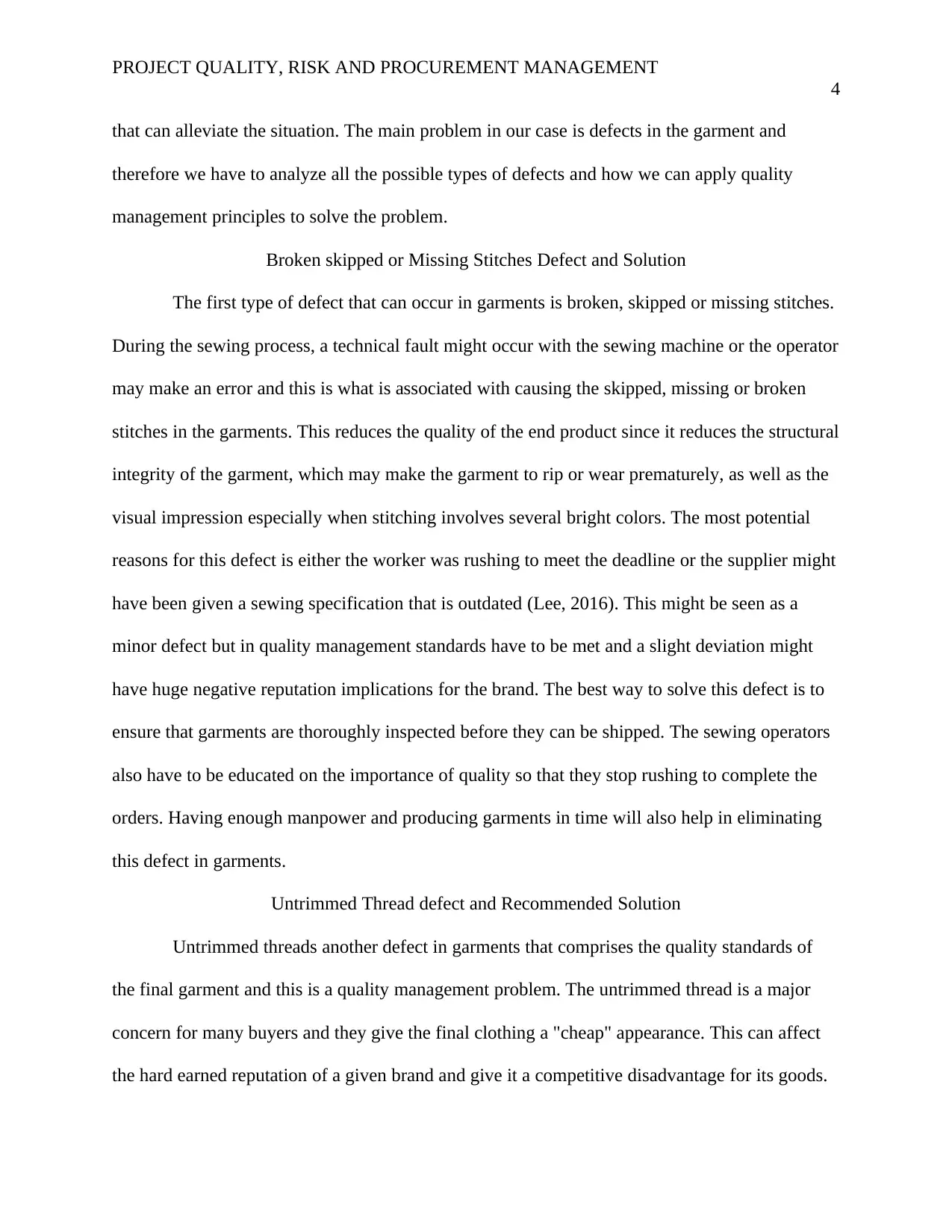
PROJECT QUALITY, RISK AND PROCUREMENT MANAGEMENT
4
that can alleviate the situation. The main problem in our case is defects in the garment and
therefore we have to analyze all the possible types of defects and how we can apply quality
management principles to solve the problem.
Broken skipped or Missing Stitches Defect and Solution
The first type of defect that can occur in garments is broken, skipped or missing stitches.
During the sewing process, a technical fault might occur with the sewing machine or the operator
may make an error and this is what is associated with causing the skipped, missing or broken
stitches in the garments. This reduces the quality of the end product since it reduces the structural
integrity of the garment, which may make the garment to rip or wear prematurely, as well as the
visual impression especially when stitching involves several bright colors. The most potential
reasons for this defect is either the worker was rushing to meet the deadline or the supplier might
have been given a sewing specification that is outdated (Lee, 2016). This might be seen as a
minor defect but in quality management standards have to be met and a slight deviation might
have huge negative reputation implications for the brand. The best way to solve this defect is to
ensure that garments are thoroughly inspected before they can be shipped. The sewing operators
also have to be educated on the importance of quality so that they stop rushing to complete the
orders. Having enough manpower and producing garments in time will also help in eliminating
this defect in garments.
Untrimmed Thread defect and Recommended Solution
Untrimmed threads another defect in garments that comprises the quality standards of
the final garment and this is a quality management problem. The untrimmed thread is a major
concern for many buyers and they give the final clothing a "cheap" appearance. This can affect
the hard earned reputation of a given brand and give it a competitive disadvantage for its goods.
4
that can alleviate the situation. The main problem in our case is defects in the garment and
therefore we have to analyze all the possible types of defects and how we can apply quality
management principles to solve the problem.
Broken skipped or Missing Stitches Defect and Solution
The first type of defect that can occur in garments is broken, skipped or missing stitches.
During the sewing process, a technical fault might occur with the sewing machine or the operator
may make an error and this is what is associated with causing the skipped, missing or broken
stitches in the garments. This reduces the quality of the end product since it reduces the structural
integrity of the garment, which may make the garment to rip or wear prematurely, as well as the
visual impression especially when stitching involves several bright colors. The most potential
reasons for this defect is either the worker was rushing to meet the deadline or the supplier might
have been given a sewing specification that is outdated (Lee, 2016). This might be seen as a
minor defect but in quality management standards have to be met and a slight deviation might
have huge negative reputation implications for the brand. The best way to solve this defect is to
ensure that garments are thoroughly inspected before they can be shipped. The sewing operators
also have to be educated on the importance of quality so that they stop rushing to complete the
orders. Having enough manpower and producing garments in time will also help in eliminating
this defect in garments.
Untrimmed Thread defect and Recommended Solution
Untrimmed threads another defect in garments that comprises the quality standards of
the final garment and this is a quality management problem. The untrimmed thread is a major
concern for many buyers and they give the final clothing a "cheap" appearance. This can affect
the hard earned reputation of a given brand and give it a competitive disadvantage for its goods.
Paraphrase This Document
Need a fresh take? Get an instant paraphrase of this document with our AI Paraphraser
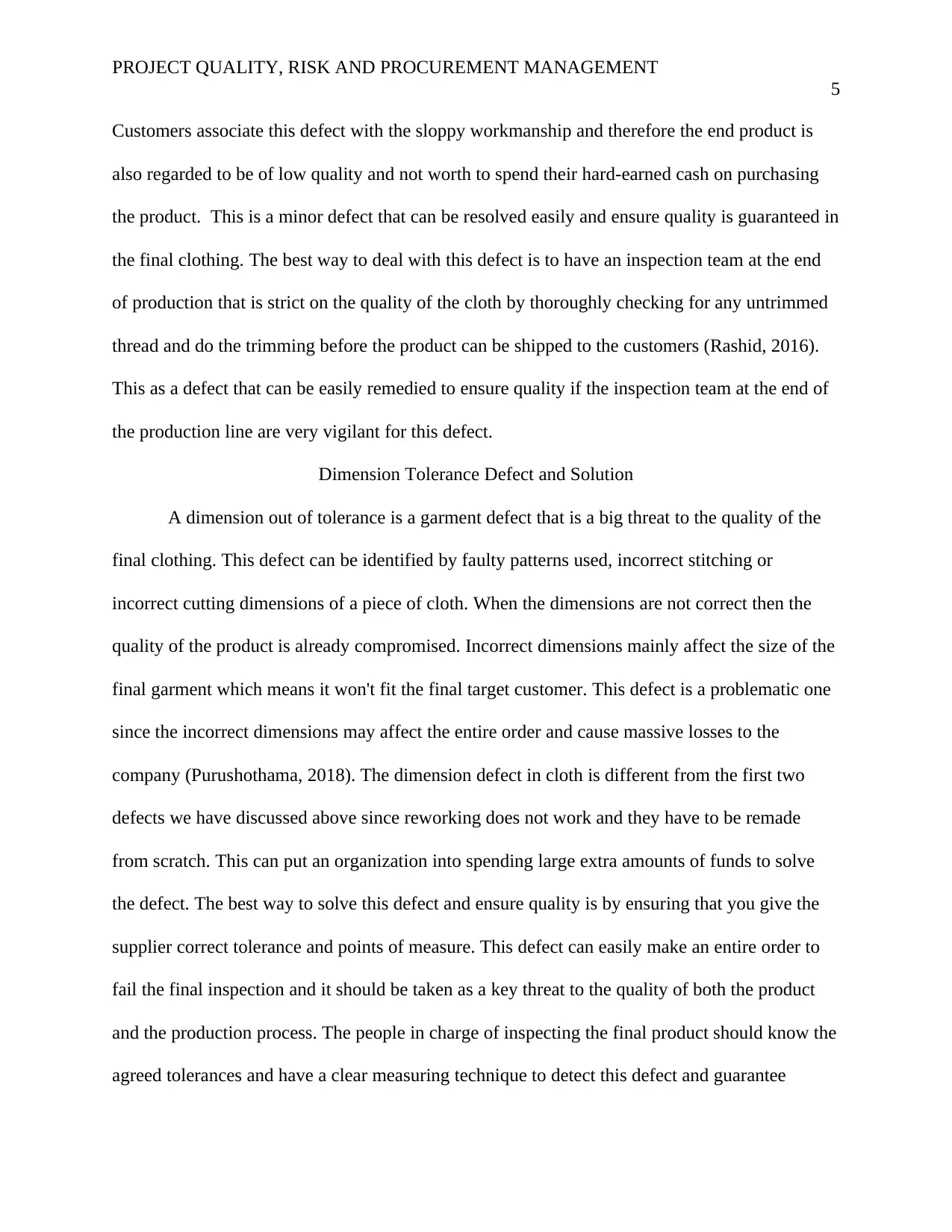
PROJECT QUALITY, RISK AND PROCUREMENT MANAGEMENT
5
Customers associate this defect with the sloppy workmanship and therefore the end product is
also regarded to be of low quality and not worth to spend their hard-earned cash on purchasing
the product. This is a minor defect that can be resolved easily and ensure quality is guaranteed in
the final clothing. The best way to deal with this defect is to have an inspection team at the end
of production that is strict on the quality of the cloth by thoroughly checking for any untrimmed
thread and do the trimming before the product can be shipped to the customers (Rashid, 2016).
This as a defect that can be easily remedied to ensure quality if the inspection team at the end of
the production line are very vigilant for this defect.
Dimension Tolerance Defect and Solution
A dimension out of tolerance is a garment defect that is a big threat to the quality of the
final clothing. This defect can be identified by faulty patterns used, incorrect stitching or
incorrect cutting dimensions of a piece of cloth. When the dimensions are not correct then the
quality of the product is already compromised. Incorrect dimensions mainly affect the size of the
final garment which means it won't fit the final target customer. This defect is a problematic one
since the incorrect dimensions may affect the entire order and cause massive losses to the
company (Purushothama, 2018). The dimension defect in cloth is different from the first two
defects we have discussed above since reworking does not work and they have to be remade
from scratch. This can put an organization into spending large extra amounts of funds to solve
the defect. The best way to solve this defect and ensure quality is by ensuring that you give the
supplier correct tolerance and points of measure. This defect can easily make an entire order to
fail the final inspection and it should be taken as a key threat to the quality of both the product
and the production process. The people in charge of inspecting the final product should know the
agreed tolerances and have a clear measuring technique to detect this defect and guarantee
5
Customers associate this defect with the sloppy workmanship and therefore the end product is
also regarded to be of low quality and not worth to spend their hard-earned cash on purchasing
the product. This is a minor defect that can be resolved easily and ensure quality is guaranteed in
the final clothing. The best way to deal with this defect is to have an inspection team at the end
of production that is strict on the quality of the cloth by thoroughly checking for any untrimmed
thread and do the trimming before the product can be shipped to the customers (Rashid, 2016).
This as a defect that can be easily remedied to ensure quality if the inspection team at the end of
the production line are very vigilant for this defect.
Dimension Tolerance Defect and Solution
A dimension out of tolerance is a garment defect that is a big threat to the quality of the
final clothing. This defect can be identified by faulty patterns used, incorrect stitching or
incorrect cutting dimensions of a piece of cloth. When the dimensions are not correct then the
quality of the product is already compromised. Incorrect dimensions mainly affect the size of the
final garment which means it won't fit the final target customer. This defect is a problematic one
since the incorrect dimensions may affect the entire order and cause massive losses to the
company (Purushothama, 2018). The dimension defect in cloth is different from the first two
defects we have discussed above since reworking does not work and they have to be remade
from scratch. This can put an organization into spending large extra amounts of funds to solve
the defect. The best way to solve this defect and ensure quality is by ensuring that you give the
supplier correct tolerance and points of measure. This defect can easily make an entire order to
fail the final inspection and it should be taken as a key threat to the quality of both the product
and the production process. The people in charge of inspecting the final product should know the
agreed tolerances and have a clear measuring technique to detect this defect and guarantee
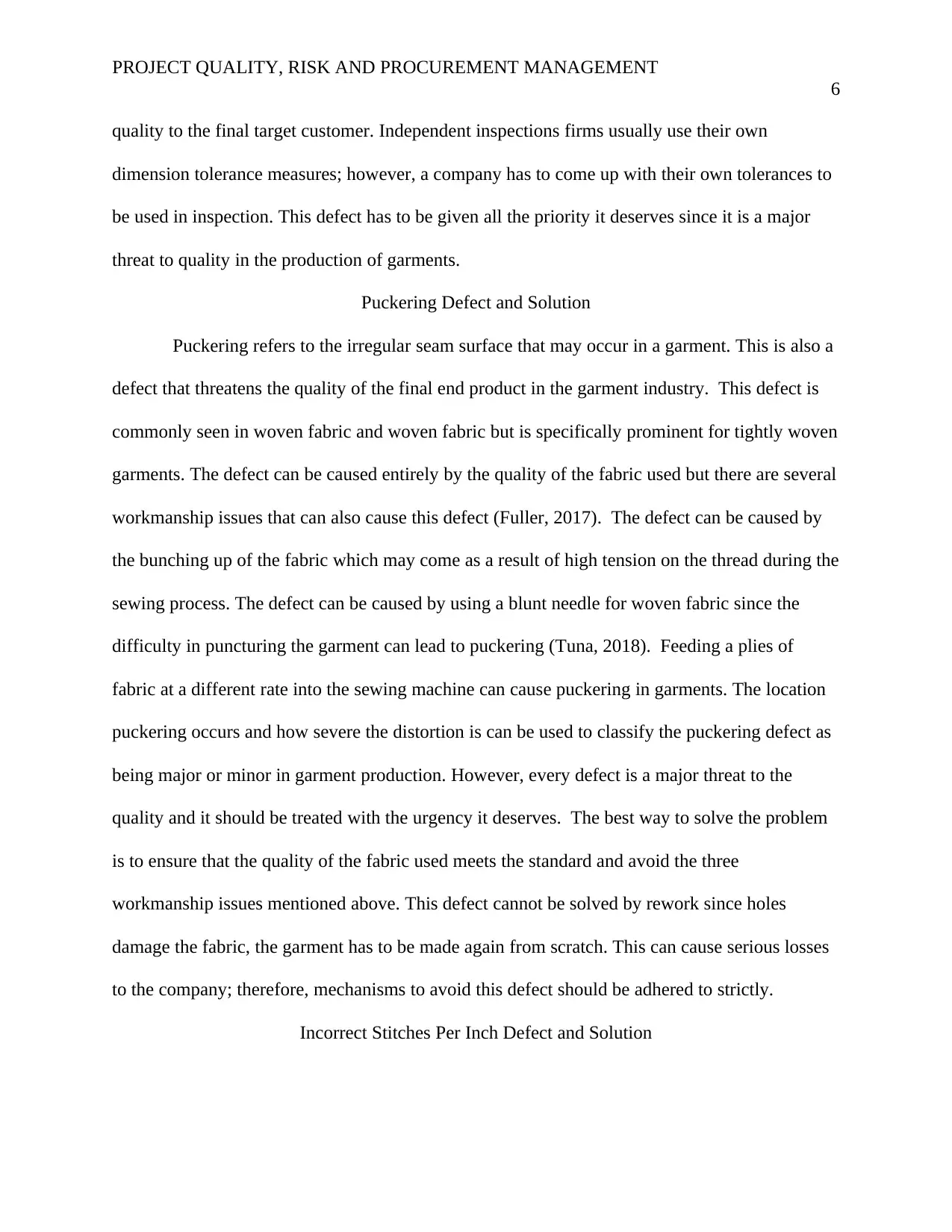
PROJECT QUALITY, RISK AND PROCUREMENT MANAGEMENT
6
quality to the final target customer. Independent inspections firms usually use their own
dimension tolerance measures; however, a company has to come up with their own tolerances to
be used in inspection. This defect has to be given all the priority it deserves since it is a major
threat to quality in the production of garments.
Puckering Defect and Solution
Puckering refers to the irregular seam surface that may occur in a garment. This is also a
defect that threatens the quality of the final end product in the garment industry. This defect is
commonly seen in woven fabric and woven fabric but is specifically prominent for tightly woven
garments. The defect can be caused entirely by the quality of the fabric used but there are several
workmanship issues that can also cause this defect (Fuller, 2017). The defect can be caused by
the bunching up of the fabric which may come as a result of high tension on the thread during the
sewing process. The defect can be caused by using a blunt needle for woven fabric since the
difficulty in puncturing the garment can lead to puckering (Tuna, 2018). Feeding a plies of
fabric at a different rate into the sewing machine can cause puckering in garments. The location
puckering occurs and how severe the distortion is can be used to classify the puckering defect as
being major or minor in garment production. However, every defect is a major threat to the
quality and it should be treated with the urgency it deserves. The best way to solve the problem
is to ensure that the quality of the fabric used meets the standard and avoid the three
workmanship issues mentioned above. This defect cannot be solved by rework since holes
damage the fabric, the garment has to be made again from scratch. This can cause serious losses
to the company; therefore, mechanisms to avoid this defect should be adhered to strictly.
Incorrect Stitches Per Inch Defect and Solution
6
quality to the final target customer. Independent inspections firms usually use their own
dimension tolerance measures; however, a company has to come up with their own tolerances to
be used in inspection. This defect has to be given all the priority it deserves since it is a major
threat to quality in the production of garments.
Puckering Defect and Solution
Puckering refers to the irregular seam surface that may occur in a garment. This is also a
defect that threatens the quality of the final end product in the garment industry. This defect is
commonly seen in woven fabric and woven fabric but is specifically prominent for tightly woven
garments. The defect can be caused entirely by the quality of the fabric used but there are several
workmanship issues that can also cause this defect (Fuller, 2017). The defect can be caused by
the bunching up of the fabric which may come as a result of high tension on the thread during the
sewing process. The defect can be caused by using a blunt needle for woven fabric since the
difficulty in puncturing the garment can lead to puckering (Tuna, 2018). Feeding a plies of
fabric at a different rate into the sewing machine can cause puckering in garments. The location
puckering occurs and how severe the distortion is can be used to classify the puckering defect as
being major or minor in garment production. However, every defect is a major threat to the
quality and it should be treated with the urgency it deserves. The best way to solve the problem
is to ensure that the quality of the fabric used meets the standard and avoid the three
workmanship issues mentioned above. This defect cannot be solved by rework since holes
damage the fabric, the garment has to be made again from scratch. This can cause serious losses
to the company; therefore, mechanisms to avoid this defect should be adhered to strictly.
Incorrect Stitches Per Inch Defect and Solution
⊘ This is a preview!⊘
Do you want full access?
Subscribe today to unlock all pages.

Trusted by 1+ million students worldwide
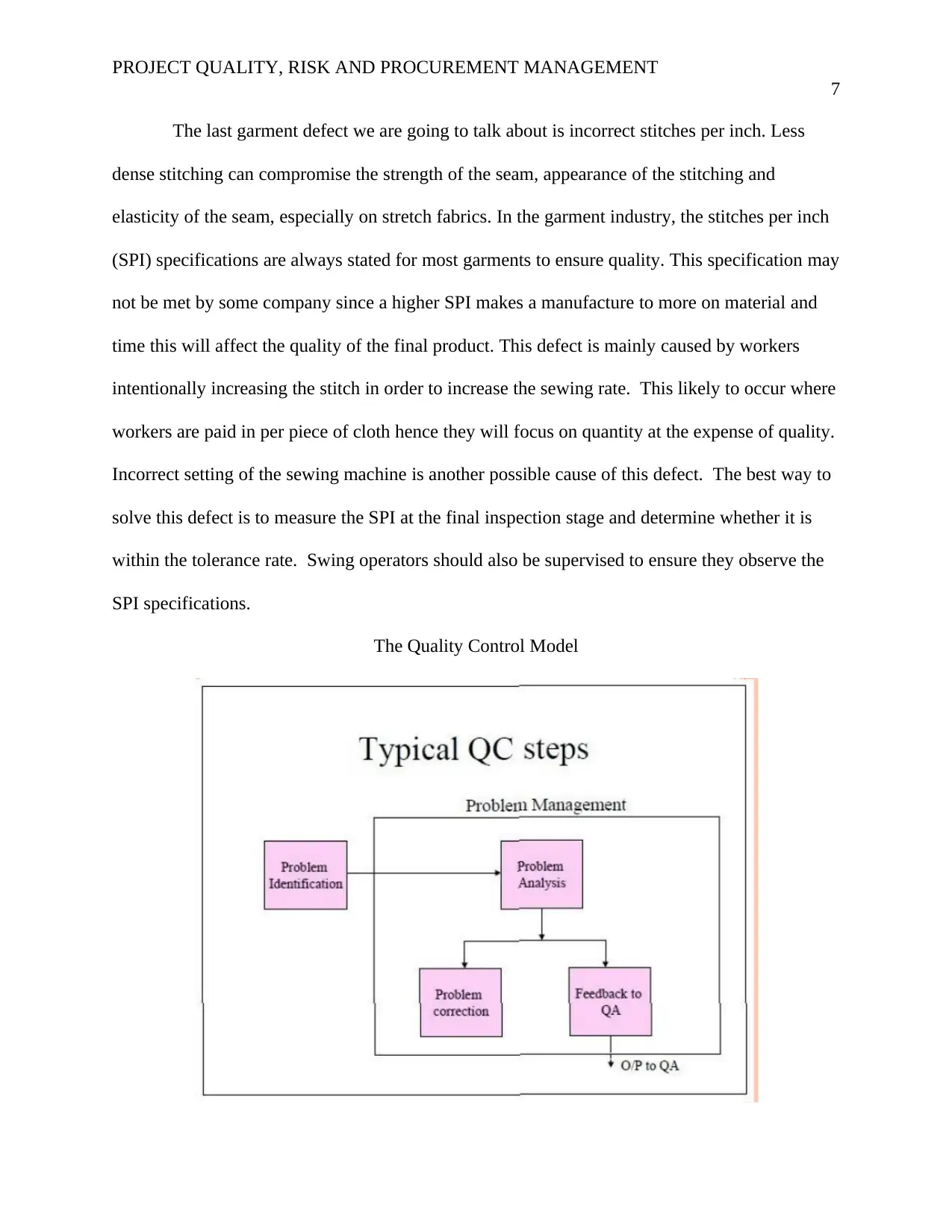
PROJECT QUALITY, RISK AND PROCUREMENT MANAGEMENT
7
The last garment defect we are going to talk about is incorrect stitches per inch. Less
dense stitching can compromise the strength of the seam, appearance of the stitching and
elasticity of the seam, especially on stretch fabrics. In the garment industry, the stitches per inch
(SPI) specifications are always stated for most garments to ensure quality. This specification may
not be met by some company since a higher SPI makes a manufacture to more on material and
time this will affect the quality of the final product. This defect is mainly caused by workers
intentionally increasing the stitch in order to increase the sewing rate. This likely to occur where
workers are paid in per piece of cloth hence they will focus on quantity at the expense of quality.
Incorrect setting of the sewing machine is another possible cause of this defect. The best way to
solve this defect is to measure the SPI at the final inspection stage and determine whether it is
within the tolerance rate. Swing operators should also be supervised to ensure they observe the
SPI specifications.
The Quality Control Model
7
The last garment defect we are going to talk about is incorrect stitches per inch. Less
dense stitching can compromise the strength of the seam, appearance of the stitching and
elasticity of the seam, especially on stretch fabrics. In the garment industry, the stitches per inch
(SPI) specifications are always stated for most garments to ensure quality. This specification may
not be met by some company since a higher SPI makes a manufacture to more on material and
time this will affect the quality of the final product. This defect is mainly caused by workers
intentionally increasing the stitch in order to increase the sewing rate. This likely to occur where
workers are paid in per piece of cloth hence they will focus on quantity at the expense of quality.
Incorrect setting of the sewing machine is another possible cause of this defect. The best way to
solve this defect is to measure the SPI at the final inspection stage and determine whether it is
within the tolerance rate. Swing operators should also be supervised to ensure they observe the
SPI specifications.
The Quality Control Model
Paraphrase This Document
Need a fresh take? Get an instant paraphrase of this document with our AI Paraphraser
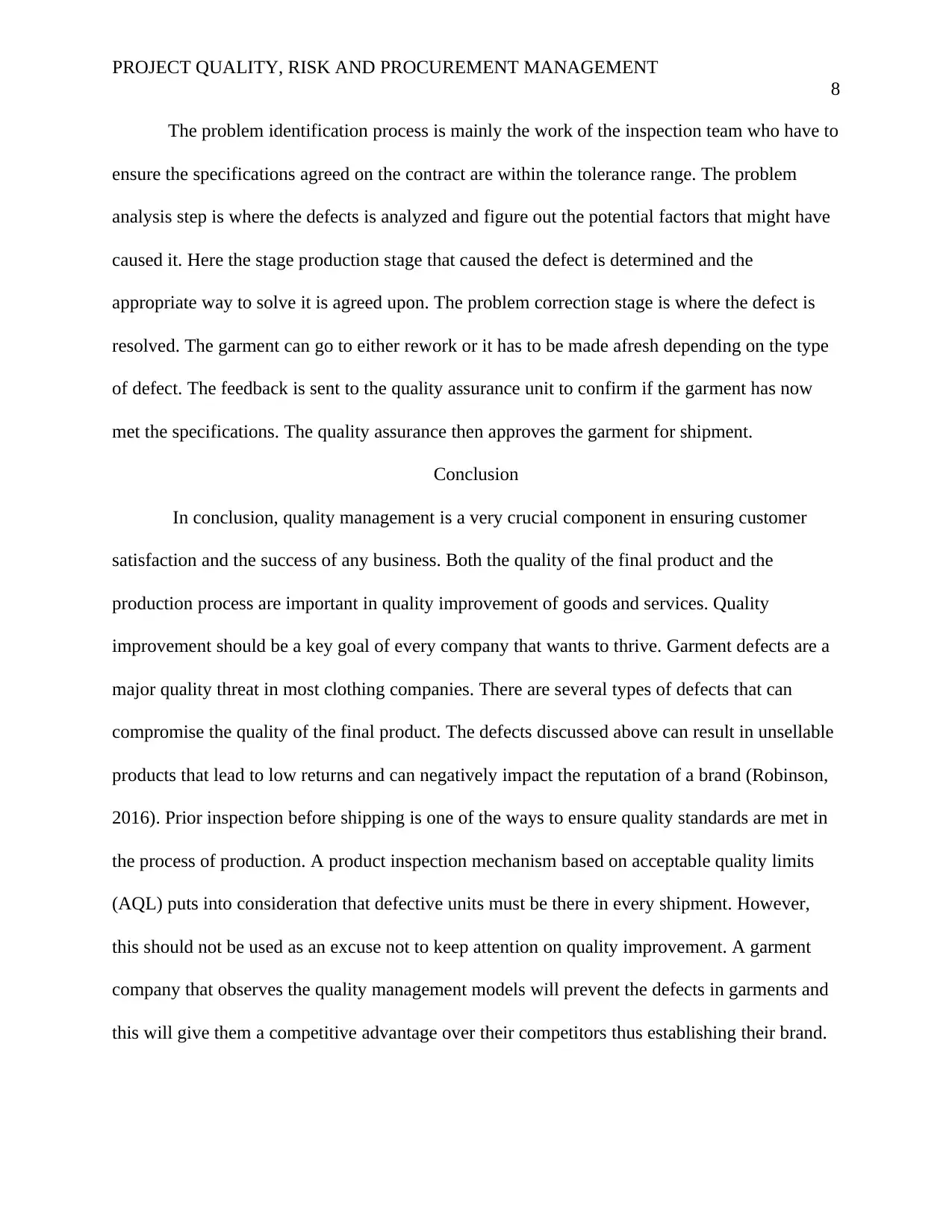
PROJECT QUALITY, RISK AND PROCUREMENT MANAGEMENT
8
The problem identification process is mainly the work of the inspection team who have to
ensure the specifications agreed on the contract are within the tolerance range. The problem
analysis step is where the defects is analyzed and figure out the potential factors that might have
caused it. Here the stage production stage that caused the defect is determined and the
appropriate way to solve it is agreed upon. The problem correction stage is where the defect is
resolved. The garment can go to either rework or it has to be made afresh depending on the type
of defect. The feedback is sent to the quality assurance unit to confirm if the garment has now
met the specifications. The quality assurance then approves the garment for shipment.
Conclusion
In conclusion, quality management is a very crucial component in ensuring customer
satisfaction and the success of any business. Both the quality of the final product and the
production process are important in quality improvement of goods and services. Quality
improvement should be a key goal of every company that wants to thrive. Garment defects are a
major quality threat in most clothing companies. There are several types of defects that can
compromise the quality of the final product. The defects discussed above can result in unsellable
products that lead to low returns and can negatively impact the reputation of a brand (Robinson,
2016). Prior inspection before shipping is one of the ways to ensure quality standards are met in
the process of production. A product inspection mechanism based on acceptable quality limits
(AQL) puts into consideration that defective units must be there in every shipment. However,
this should not be used as an excuse not to keep attention on quality improvement. A garment
company that observes the quality management models will prevent the defects in garments and
this will give them a competitive advantage over their competitors thus establishing their brand.
8
The problem identification process is mainly the work of the inspection team who have to
ensure the specifications agreed on the contract are within the tolerance range. The problem
analysis step is where the defects is analyzed and figure out the potential factors that might have
caused it. Here the stage production stage that caused the defect is determined and the
appropriate way to solve it is agreed upon. The problem correction stage is where the defect is
resolved. The garment can go to either rework or it has to be made afresh depending on the type
of defect. The feedback is sent to the quality assurance unit to confirm if the garment has now
met the specifications. The quality assurance then approves the garment for shipment.
Conclusion
In conclusion, quality management is a very crucial component in ensuring customer
satisfaction and the success of any business. Both the quality of the final product and the
production process are important in quality improvement of goods and services. Quality
improvement should be a key goal of every company that wants to thrive. Garment defects are a
major quality threat in most clothing companies. There are several types of defects that can
compromise the quality of the final product. The defects discussed above can result in unsellable
products that lead to low returns and can negatively impact the reputation of a brand (Robinson,
2016). Prior inspection before shipping is one of the ways to ensure quality standards are met in
the process of production. A product inspection mechanism based on acceptable quality limits
(AQL) puts into consideration that defective units must be there in every shipment. However,
this should not be used as an excuse not to keep attention on quality improvement. A garment
company that observes the quality management models will prevent the defects in garments and
this will give them a competitive advantage over their competitors thus establishing their brand.
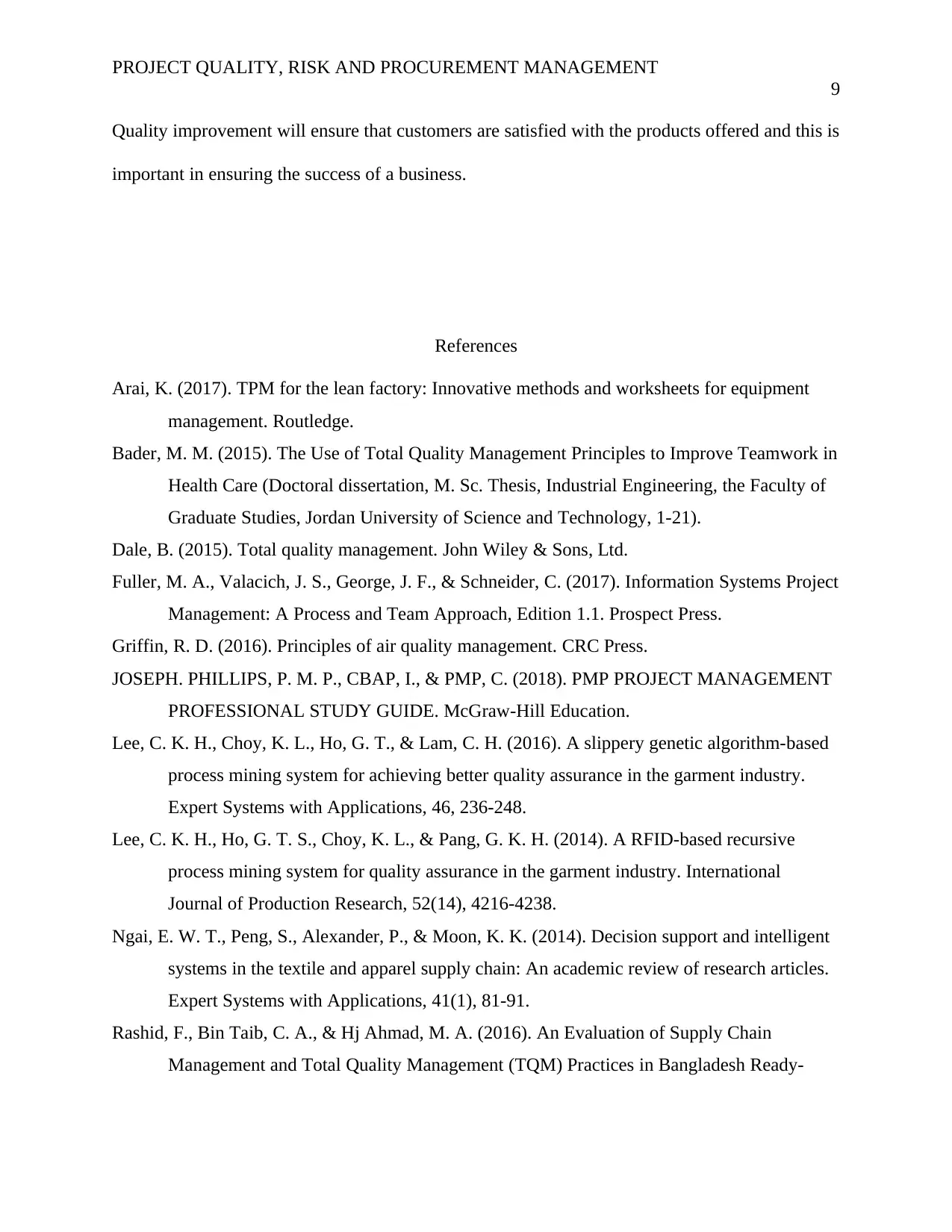
PROJECT QUALITY, RISK AND PROCUREMENT MANAGEMENT
9
Quality improvement will ensure that customers are satisfied with the products offered and this is
important in ensuring the success of a business.
References
Arai, K. (2017). TPM for the lean factory: Innovative methods and worksheets for equipment
management. Routledge.
Bader, M. M. (2015). The Use of Total Quality Management Principles to Improve Teamwork in
Health Care (Doctoral dissertation, M. Sc. Thesis, Industrial Engineering, the Faculty of
Graduate Studies, Jordan University of Science and Technology, 1-21).
Dale, B. (2015). Total quality management. John Wiley & Sons, Ltd.
Fuller, M. A., Valacich, J. S., George, J. F., & Schneider, C. (2017). Information Systems Project
Management: A Process and Team Approach, Edition 1.1. Prospect Press.
Griffin, R. D. (2016). Principles of air quality management. CRC Press.
JOSEPH. PHILLIPS, P. M. P., CBAP, I., & PMP, C. (2018). PMP PROJECT MANAGEMENT
PROFESSIONAL STUDY GUIDE. McGraw-Hill Education.
Lee, C. K. H., Choy, K. L., Ho, G. T., & Lam, C. H. (2016). A slippery genetic algorithm-based
process mining system for achieving better quality assurance in the garment industry.
Expert Systems with Applications, 46, 236-248.
Lee, C. K. H., Ho, G. T. S., Choy, K. L., & Pang, G. K. H. (2014). A RFID-based recursive
process mining system for quality assurance in the garment industry. International
Journal of Production Research, 52(14), 4216-4238.
Ngai, E. W. T., Peng, S., Alexander, P., & Moon, K. K. (2014). Decision support and intelligent
systems in the textile and apparel supply chain: An academic review of research articles.
Expert Systems with Applications, 41(1), 81-91.
Rashid, F., Bin Taib, C. A., & Hj Ahmad, M. A. (2016). An Evaluation of Supply Chain
Management and Total Quality Management (TQM) Practices in Bangladesh Ready-
9
Quality improvement will ensure that customers are satisfied with the products offered and this is
important in ensuring the success of a business.
References
Arai, K. (2017). TPM for the lean factory: Innovative methods and worksheets for equipment
management. Routledge.
Bader, M. M. (2015). The Use of Total Quality Management Principles to Improve Teamwork in
Health Care (Doctoral dissertation, M. Sc. Thesis, Industrial Engineering, the Faculty of
Graduate Studies, Jordan University of Science and Technology, 1-21).
Dale, B. (2015). Total quality management. John Wiley & Sons, Ltd.
Fuller, M. A., Valacich, J. S., George, J. F., & Schneider, C. (2017). Information Systems Project
Management: A Process and Team Approach, Edition 1.1. Prospect Press.
Griffin, R. D. (2016). Principles of air quality management. CRC Press.
JOSEPH. PHILLIPS, P. M. P., CBAP, I., & PMP, C. (2018). PMP PROJECT MANAGEMENT
PROFESSIONAL STUDY GUIDE. McGraw-Hill Education.
Lee, C. K. H., Choy, K. L., Ho, G. T., & Lam, C. H. (2016). A slippery genetic algorithm-based
process mining system for achieving better quality assurance in the garment industry.
Expert Systems with Applications, 46, 236-248.
Lee, C. K. H., Ho, G. T. S., Choy, K. L., & Pang, G. K. H. (2014). A RFID-based recursive
process mining system for quality assurance in the garment industry. International
Journal of Production Research, 52(14), 4216-4238.
Ngai, E. W. T., Peng, S., Alexander, P., & Moon, K. K. (2014). Decision support and intelligent
systems in the textile and apparel supply chain: An academic review of research articles.
Expert Systems with Applications, 41(1), 81-91.
Rashid, F., Bin Taib, C. A., & Hj Ahmad, M. A. (2016). An Evaluation of Supply Chain
Management and Total Quality Management (TQM) Practices in Bangladesh Ready-
⊘ This is a preview!⊘
Do you want full access?
Subscribe today to unlock all pages.

Trusted by 1+ million students worldwide
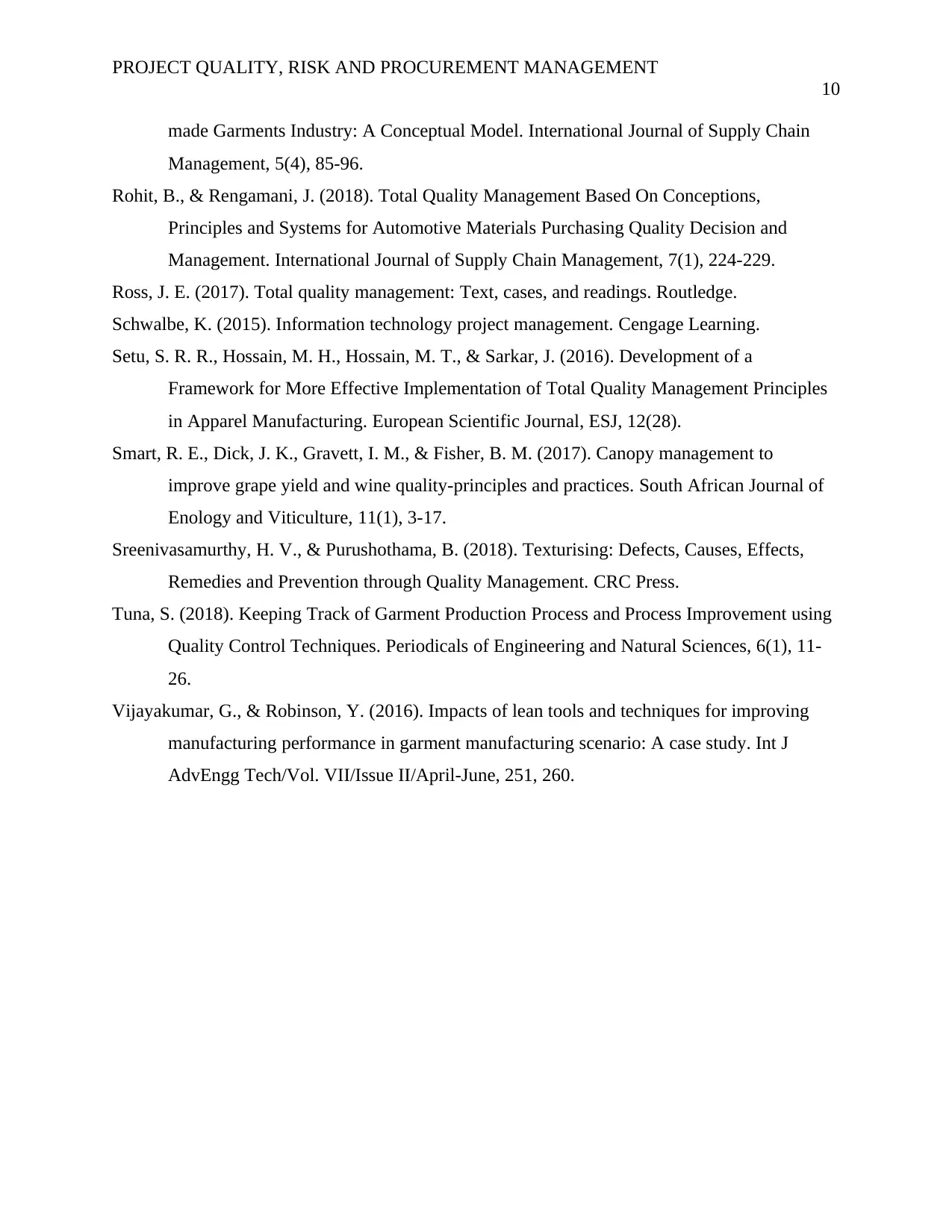
PROJECT QUALITY, RISK AND PROCUREMENT MANAGEMENT
10
made Garments Industry: A Conceptual Model. International Journal of Supply Chain
Management, 5(4), 85-96.
Rohit, B., & Rengamani, J. (2018). Total Quality Management Based On Conceptions,
Principles and Systems for Automotive Materials Purchasing Quality Decision and
Management. International Journal of Supply Chain Management, 7(1), 224-229.
Ross, J. E. (2017). Total quality management: Text, cases, and readings. Routledge.
Schwalbe, K. (2015). Information technology project management. Cengage Learning.
Setu, S. R. R., Hossain, M. H., Hossain, M. T., & Sarkar, J. (2016). Development of a
Framework for More Effective Implementation of Total Quality Management Principles
in Apparel Manufacturing. European Scientific Journal, ESJ, 12(28).
Smart, R. E., Dick, J. K., Gravett, I. M., & Fisher, B. M. (2017). Canopy management to
improve grape yield and wine quality-principles and practices. South African Journal of
Enology and Viticulture, 11(1), 3-17.
Sreenivasamurthy, H. V., & Purushothama, B. (2018). Texturising: Defects, Causes, Effects,
Remedies and Prevention through Quality Management. CRC Press.
Tuna, S. (2018). Keeping Track of Garment Production Process and Process Improvement using
Quality Control Techniques. Periodicals of Engineering and Natural Sciences, 6(1), 11-
26.
Vijayakumar, G., & Robinson, Y. (2016). Impacts of lean tools and techniques for improving
manufacturing performance in garment manufacturing scenario: A case study. Int J
AdvEngg Tech/Vol. VII/Issue II/April-June, 251, 260.
10
made Garments Industry: A Conceptual Model. International Journal of Supply Chain
Management, 5(4), 85-96.
Rohit, B., & Rengamani, J. (2018). Total Quality Management Based On Conceptions,
Principles and Systems for Automotive Materials Purchasing Quality Decision and
Management. International Journal of Supply Chain Management, 7(1), 224-229.
Ross, J. E. (2017). Total quality management: Text, cases, and readings. Routledge.
Schwalbe, K. (2015). Information technology project management. Cengage Learning.
Setu, S. R. R., Hossain, M. H., Hossain, M. T., & Sarkar, J. (2016). Development of a
Framework for More Effective Implementation of Total Quality Management Principles
in Apparel Manufacturing. European Scientific Journal, ESJ, 12(28).
Smart, R. E., Dick, J. K., Gravett, I. M., & Fisher, B. M. (2017). Canopy management to
improve grape yield and wine quality-principles and practices. South African Journal of
Enology and Viticulture, 11(1), 3-17.
Sreenivasamurthy, H. V., & Purushothama, B. (2018). Texturising: Defects, Causes, Effects,
Remedies and Prevention through Quality Management. CRC Press.
Tuna, S. (2018). Keeping Track of Garment Production Process and Process Improvement using
Quality Control Techniques. Periodicals of Engineering and Natural Sciences, 6(1), 11-
26.
Vijayakumar, G., & Robinson, Y. (2016). Impacts of lean tools and techniques for improving
manufacturing performance in garment manufacturing scenario: A case study. Int J
AdvEngg Tech/Vol. VII/Issue II/April-June, 251, 260.
1 out of 10
Related Documents
Your All-in-One AI-Powered Toolkit for Academic Success.
+13062052269
info@desklib.com
Available 24*7 on WhatsApp / Email
![[object Object]](/_next/static/media/star-bottom.7253800d.svg)
Unlock your academic potential
Copyright © 2020–2025 A2Z Services. All Rights Reserved. Developed and managed by ZUCOL.





